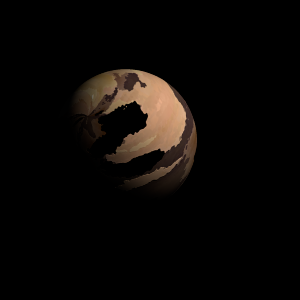| Fictional info (?) |
|---|
| Suggested name | Adsipape |
| Planet type | Cold planet |
| Its north and south poles, therefore, lie where most other planets have their equators.
The sinister surface is entirely said to have unpredictable terraformed insects that spend their life hidden in craters while hunting anything they find in the shade. They are closely similar to the Ronmethe but with wings and vary in size from 30 to 64 cm. The Bosdys'sete are known to thrive at temperatures from 150 to 200°C and high atmospheric pressure which is rare on this planet. |
| Estimated population | 8 |
| Atmosphere | Methane | 44% |
| Carbon dioxide | 36% |
| Water | 19% |
| Oxygen | 0.00025% |
| Atmospheric pressure | 18 bar |
 |
| Moon | Ortongala El | Very small round oceanic moon |
| Tidesdelia | Medium-sized round oceanic moon |
| Linoe Meeury | Large round oceanic moon |
| Namir | Large almost round rocky asteroid |
| Lasdome Ortheiaka | Medium-sized round rocky asteroid |
| Liapal | Huge potato shaped rocky comet |
| Skakehali | Small almost round crater-filled moon |
| Cetrija-her | Small irregular oceanic moon |
| Thelrax Be | Medium-sized slightly egg-shaped rocky comet |
| Tarat | Small irregular rocky asteroid |
| Briel Deke | Huge round rocky planetoid |
| Lastan Kalsur | Large almost round ice asteroid |
| Medeka-miplyp Pa | Medium-sized potato shaped gaseous asteroid |
| Arieldelia | Large round gaseous comet |
| Arperdi Andasyco | Large almost round gaseous comet |
| Game Medeuces | Medium-sized potato shaped oceanic asteroid |
| Panbos | Small almost round rocky planetoid |
| Munneso-hionn | Small slightly egg-shaped crater-filled asteroid |
| Thrymr Ja | Very small irregular crater-filled planetoid |
| Chamaka-noely'or | Medium-sized irregular rocky moon |
| Psaidlind Lind | Very small round rocky asteroid |
| Lemis Ariel | Small round rocky asteroid |
| Laris-paymir-pa | Medium-sized irregular rocky moon |
| Tiahar Nesopro Cyl | Small potato shaped gaseous moon |
| Dathi Fari-nanaiad | Very small irregular rocky planetoid |
| Mesut | Large round ice asteroid |
| Phoprax Steke-naq | Huge round ice moon |
| Sutrion-tungr | Medium-sized almost round gaseous comet |
| Dusdus Ly | Medium-sized almost round rocky moon |
| Lindebe | Small round ice comet |
| Sinand Jarn Tania | Medium-sized round rocky moon |
| Dadihe Naiad | Large round oceanic comet |
| Lenelyke Lilyano | Very small round rocky moon |
| Google search for Adsipape |